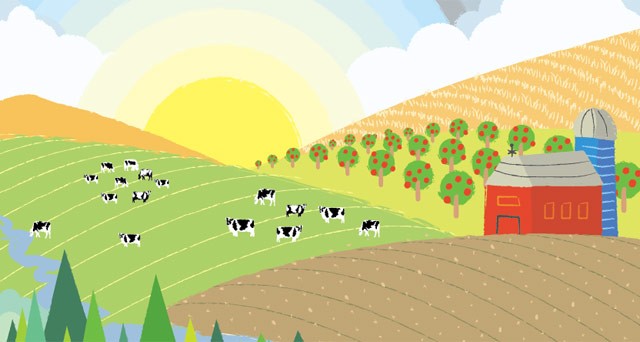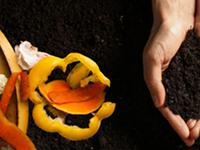[
{
"name": "500x250 Ad",
"insertPoint": "5",
"component": "15667920",
"parentWrapperClass": "",
"requiredCountToDisplay": "1"
}
]
So much of farming depends on the weather.
Too much rain in the spring can delay crop planting. Cows respond to high temperatures by producing less milk. And cold winters keep crop pests and diseases in check.
Weather varies from year to year: a fact of life that farmers must accept. They know that some springs will be wetter than others and that some summers will bring scorching droughts. And whether it's a wet, dry, or balanced year affects crop yields.
"I guess you've got to roll with the punches," says Kurt Forman, operator and part owner of Clearview Farm in Ontario County.
But climate change is manifesting in the form of quantifiable, long-term trends that go beyond the typical year-to-year variability of weather. For example, precipitation patterns are changing and the growing season has gradually become days longer. Climate change also creates a degree of uncertainty about future growing conditions.
The US Department of Agriculture illustrated one trend when it released its updated plant hardiness zones, which many growers and gardeners use to guide their plantings. This year, the USDA updated the map for the first time in 12 years, and parts of Monroe County were moved into a slightly warmer zone. The reason: over 30 years, the average extreme cold temperatures in the region have gotten less so.
In general, average temperatures across New York are gradually increasing.
Agriculture is a significant industry in New York. It generated approximately $4.7 billion in 2010, says a fact sheet from the state Department of Agriculture and Markets. Dairy alone is a $2.2 billion business in New York; the state is the fourth-largest dairy producer in the country. It's the second-largest producer of cabbage and apples, and the third-largest grape and wine producer. New York also ranks high in production of tart cherries, sweet corn, pears, onions, and maple syrup.
Many of these crops — livestock, too — are sensitive to certain weather conditions. A poorly-timed frost, for example, can damage apple and grape crops. That happened to New York growers this spring; peach and cherry crops were also damaged.
But New York's farmers have to think beyond local weather and climate. Many crops are sold into and compete in global markets. If Midwest wheat production tanks, for example, Russia's wheat crop becomes more valuable and more important to the global food supply. Or if shifts in climate change shake up European winemaking but improve conditions for Finger Lakes growers, local wines could rise in stature. And local wineries could sell more product.
The science is clear: human activities, particularly the use of fossil fuels, are altering global climates. The world's governments and populations have failed to take the actions necessary to stop climate change and farmers must now adapt.
Plants and crops need water, but too much at the wrong time or too little over an extended period can cause problems.
"I think we're having more extremes," says Forman, the Ontario County organic farmer. "We'll get some really, really wet weather and then we'll get some really, really dry weather."
Forman says his biggest fear is a growing season that starts out very wet and then turns very dry. That happened last year when the region had a wet spring, but then turned dry. If it's wet early, the plants don't grow as far into the ground, where the soil takes longer to dry out. If the weather turns dry and stays dry, then the plants can't get the moisture they need.
Last year's dry spell ended in July and Forman used the opportunity to plant a second round of vegetable crops, including summer squash, basil, cilantro, and bok choy. He had some success. Aided by mild temperatures, Forman harvested bok choy into December.
Research backs up Forman's observations about extremes. Patterns of precipitation and dryness are changing across New York. The Rochester area is seeing more heavy rain, defined as an inch or more in a day, than it has in the past, and storms are becoming more intense. Researchers expect that trend to continue. They also project that short-term summer droughts will become increasingly likely as the century advances.
Those trends have real implications for farmers.
Last year's drought put a lot of stress on Forman's cabbage-family crops, he says. The dry weather was a challenge on its own, but it also contributed to insect problems. Ultimately, beetles killed the plants.
"We did not get anything out of them at all," Forman says. "And that's something that I've never experienced before."
To understand the threat that drought poses to agriculture, look at the Midwest. The region has been suffering through high temperatures and drought, and farmers and scientists expect significant corn and soybean crop losses across much of that region.
And last week, the US Department of Agriculture announced that more than 1,000 counties across 26 states would be declared disaster areas because of drought.
The Midwest is the top corn-producing region in the world. If it loses a lot of its crop, food prices could go up, since corn is an ingredient in many products. Farmers could also see an increase in livestock feed costs, which would likely translate to higher meat and dairy prices for consumers.
Corn losses could even mean gas price increases. Much of the country's gas supply is blended with some percentage of corn ethanol.
If the Midwest faces long-term challenges to corn growing, New York's farmers may see some financial incentive — and pressure — to increase their corn acreage.
But New York's farmers aren't immune to droughts, themselves. They will, however, have mitigation options. The state has lots of freshwater resources which farmers can use for irrigation, including two Great Lakes, the Finger Lakes, and several rivers. For at least some farmers, however, that may mean purchasing expensive new equipment.
Average temperatures, particularly winter temperatures, are increasing across New York.
Average temperatures have increased by 0.5 degrees Fahrenheit each decade since the 1970's, says a comprehensive climate report published earlier this year by the New York State Energy Research and Development Authority. Average winter temperatures have increased by 1.2 degrees Fahrenheit each decade, the report says.
The report predicts milder winters heading into the future, too. It says that the Rochester area traditionally has 133 days a year where the temperature is 32 degrees Fahrenheit or lower. But by the 2080's, between 53 and 106 days could fall below that same threshold, the report says.
The temperature shifts could bring opportunities for grape growers and wineries. Longer growing seasons combined with warmer winters would provide vineyards with better conditions for cultivating European red grapes.
"Historically in our area, we've been able to do the whites pretty well: rieslings and some of those," says David Wolfe, a professor of plant and soil ecology at Cornell University. "But the cabernets and the merlots, those red wine grapes, they need a longer growing season, a little bit warmer temperatures."
But climate change may create some challenges for the European wine regions that have traditionally bred and grown these varietals.
France, Italy, and Spain tend to produce and classify wines by region: think Burgundy, Chianti, or Rioja. An article published in February by Yale Environment 360 says that climate change could mean that the regions that traditionally grow specific grapes will no longer provide optimal conditions for those varietals.
The US wine industry is newer than Europe's and does not have the centuries of winemaking tradition that some European countries have. So American winemakers would have more flexibility to shift their production areas, the article says.
Grapes and wine represent the nature of adaptation: embracing opportunities as well as anticipating and responding to problems.
And while warmer temperatures may mean opportunities for grape growers, they don't erase a key risk: frost.
Mild winters like the one the Rochester area just had can result in plants budding earlier, when temperatures can swing significantly. If there's a frost or freeze, the buds could be stunted or killed. Fruit crops are especially vulnerable, says the NYSERDA report.
Cornell's Wolfe, who was a lead author of the agriculture section of the NYSERDA report, says that farmers now ask him about insects and crop diseases. While in the past, New York had some protection from pests, because the cold winters would kill off a lot of insects.
Crops may benefit from a longer growing season, but so may some pest insects. More warm days may lead to several generations of certain insects in a single growing season.
"It's going to be much more complex because you have to not just think about what your father and your grandfather had to face in terms of pests," Wolfe says. "But now you've got to think about what's south of you and which of those things might be coming your way."
The changing climate could make some crop diseases more prevalent, too. The NYSERDA report uses late blight — the fungus behind the Irish potato famine, though it affects tomatoes, too — as an example. Wetter weather encourages the fungus's growth. (This year, the state warned of a confirmed outbreak in Suffolk County.)
Shifts in the climate could also bring in new invasive weeds, which compete with and choke out crops and native plants.
Ultimately, farmers will have to make choices: what to plant and when to plant it, whether and how to raise livestock, and how to invest in their operations.
Wolfe says that researchers are developing forecasting tools to help farmers make those decisions. That may mean further clarifying the long-term changes in the climate. Researchers are also developing models for different regions of the state.
Farmers may have to shift planting dates, and they may have to plant different varieties of crops. For example, some apple varieties handle mild winters better than others. Diversifying crops is important, too. That way, if one crop has a bad year, farmers have another crop to fall back on. Forman says that's helped him during some tough years.
Crop farmers can also look at different ways of managing their fields. In conventional farming, crops are often sprayed with chemicals to combat pests and diseases. Integrated pest management is a popular alternative that makes chemical applications a last resort. It instead relies on crop diversity, soil health, analysis, and monitoring. But there's a catch: the state keeps trying to cut funding for integrated pest management programs.
Dairy farmers have options of their own, such as putting cooling systems in the barns to help keep milk yields up. But it's an expensive investment that a farmer would want to weigh carefully.
"If you're building a dairy barn today, I guess what I'm saying is, you don't want to build it based on yesterday's climate," Wolfe says.
COMMENT
Speaking of Climate Change, Climate Change Series 2012
Latest in News
More by Jeremy Moule
-

ROCHESTER TEN
ANNETTE RAMOSAug 1, 2023 - More »










